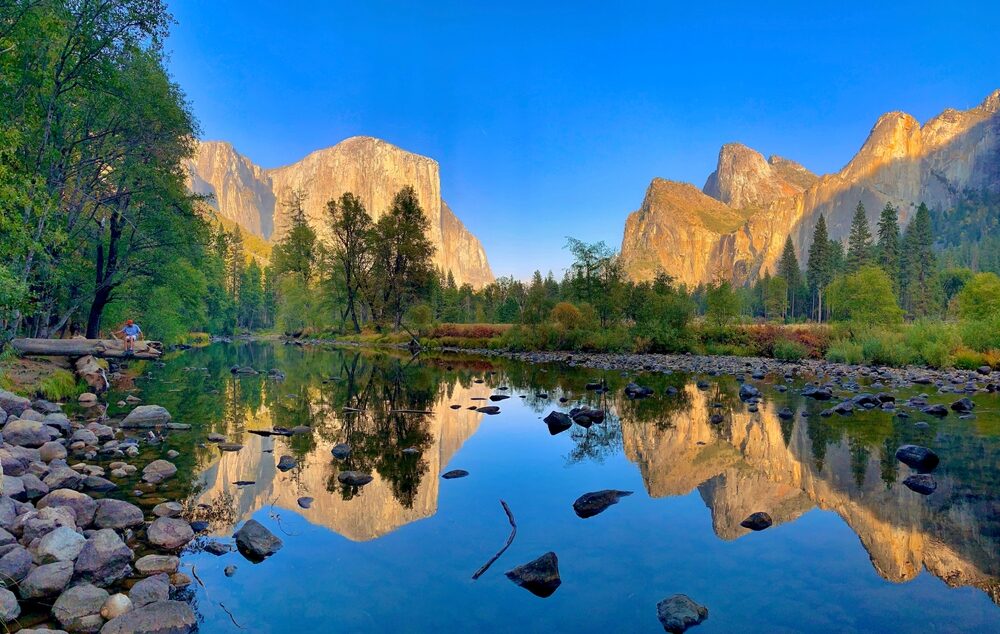
A Journey Through America’s National Parks
The land seemed to breathe.
- Author:
- Christopher Truffa
- Date:
- August 11 2025
Somewhere between the high desert of Nevada and the rugged edge of southwestern Utah, I pulled over to let it sink in. The road had risen and fallen for hours, weaving past sunbaked rock and distant mesas, until suddenly—there it was. Bryce Canyon. A vast amphitheater of flame-colored stone, silent as an ancient cathedral and carved by time into spires, the earth seemed to have grown from bone and fire. I stood at the rim, the wind cool despite the summer sun, and felt something unspoken take root.
I had come looking for space, the kind you can't find in the margins of emails or the pause between meetings, but I found something else entirely. A different kind of time. A slow, deliberate time. The kind that doesn’t demand but invites. And somewhere between Bryce and Zion, on a long drive from California to Colorado, I realized that these National Parks are not merely places we visit. They are places that shape us. In them, we remember how to grow.
A Nation’s Mirror in the Wilderness
Long before the word “park” was ever affixed to these landscapes, long before wagon trails and camera lenses, this land was alive with story. For millennia, Indigenous peoples lived in rhythm with what we now call national treasures, the Ancestral Puebloans of Zion, the Paiute of Bryce Canyon, and dozens more, whose knowledge of land, water, and spirit sustained vibrant cultures in the very places we now “protect.”
For much of American history, the dominant myth was one of “untouched wilderness,” a blank canvas for adventure or conquest. When President Ulysses S. Grant signed the Yellowstone National Park Protection Act in 1872, creating the world’s first national park, it was hailed as a bold act of preservation, and it was. Still, it was also the beginning of a complicated relationship between people, land, and power.
The park idea grew not just from love of nature, but from fear of losing it. Industrialization rapidly changed the American landscape in the 19th century, and voices like John Muir rose in response, urging a return to what he called the “temple of nature.” Muir, a Scottish-born naturalist and prolific writer, was instrumental in founding Yosemite National Park and became a fierce advocate for wild spaces. President Theodore Roosevelt, captivated by Muir’s vision, used his authority to preserve millions of acres through national parks, monuments, and forests.
Yet even in these early victories, tension brewed. What was preserved, and for whom it was maintained, often excluded the people who had called these lands home for centuries. The displacement of Native communities from parklands is a history frequently left untold at trailheads and visitor centers. However, it is crucial to understand that parks are not pristine time capsules but evolving landscapes where cultural and natural elements could merge.
Over the next century, the National Park System grew alongside the nation. During the Great Depression, the Civilian Conservation Corps built trails, bridges, and lodges, marrying conservation with employment. After World War II, family road trips became a rite of passage, and the parks became emblematic of American freedom, even as battles over access, segregation, and land use continued beneath the surface.
Today, there are 63 National Parks and more than 400 units managed by the National Park Service, ranging from battlefields to seashores, monuments to memorials. They are our collective inheritance. They also reflect who we were, who we are, and who we might yet become.
Driving east from California, the land began to change long before I crossed into Utah. The terrain unfolded like a story, coastal haze fading into desert starkness, and then into something wilder. After the surreal stone forest of Bryce Canyon, where the hoodoos rise like frozen flames, I turned south toward Zion. The road narrowed, then wound downward through red rock corridors where the air itself seemed thick with meaning.
“Zion” — a word that has echoed across cultures and centuries. In ancient Hebrew, it was a name for Jerusalem, a city of peace, refuge, and divine presence. When Mormon settlers arrived in Utah in the mid-1800s, they looked upon the towering canyon walls and saw a promised land, naming it Zion for the sanctuary they believed it represented.
But names, like landscapes, evolve. The park's original name was Mukuntuweap, a Southern Paiute term meaning “straight canyon,” chosen by early explorer John Wesley Powell. In 1918, Horace Albright, then acting director of the National Park Service, pushed to change it, fearing that “Mukuntuweap” was too tricky for eastern visitors to pronounce, an erasure that speaks volumes about whose stories were preserved, and whose were lost.
Still, standing in the shadow of Zion’s sandstone cliffs, it is impossible not to feel the weight of time. The Virgin River has carved these walls for eons, and the canyon floor is alive with cottonwoods, deer, and the hush of wind through narrow slots. Hiking the Narrows — where water becomes trail, I was struck by how small and free I felt. There is humility in walking, where the land dictates your path and you yield to something older and wiser than yourself.
A Living Legacy: What the Parks Teach Us
Names like Zion, Bryce, Yellowstone, and Yosemite carry with them stories, some sacred, some political, some practical. Yosemite comes from the Miwok word “Yohhe’meti,” meaning “those who kill,” a name born from conflict between Indigenous people and settlers. Bryce was named after Ebenezer Bryce, a Mormon pioneer who once grazed cattle near the canyon. Like the parks, the names are layered, invitations to ask more profound questions.
As I drove east into Colorado, I realized the parks are not just destinations. They are markers of how we, as a society, choose to grow. From the early days of exclusion and conquest to modern movements toward inclusion, rewilding, and climate resilience, the National Parks have become a canvas for our evolving values. Visiting them is not just an act of recreation, it is participation in a larger story.
The National Parks, One Shared Treasure
Below is a list of the 63 National Parks in the United States. Each one, from the volcanic craters of Hawaii to the glacier-fed fjords of Alaska, is a world unto itself, an invitation to wander, to wonder, and perhaps to grow.
- Acadia (Maine)
- American Samoa (American Samoa)
- Arches (Utah)
- Badlands (South Dakota)
- Big Bend (Texas)
- Biscayne (Florida)
- Black Canyon of the Gunnison (Colorado)
- Bryce Canyon (Utah)
- Canyonlands (Utah)
- Capitol Reef (Utah)
- Carlsbad Caverns (New Mexico)
- Channel Islands (California)
- Congaree (South Carolina)
- Crater Lake (Oregon)
- Cuyahoga Valley (Ohio)
- Death Valley (California, Nevada)
- Denali (Alaska)
- Dry Tortugas (Florida)
- Everglades (Florida)
- Gates of the Arctic (Alaska)
- Gateway Arch (Missouri)
- Glacier (Montana)
- Glacier Bay (Alaska)
- Grand Canyon (Arizona)
- Grand Teton (Wyoming)
- Great Basin (Nevada)
- Great Sand Dunes (Colorado)
- Great Smoky Mountains (Tennessee, North Carolina)
- Guadalupe Mountains (Texas)
- Haleakalā (Hawaii)
- Hawai'i Volcanoes (Hawaii)
- Hot Springs (Arkansas)
- Indiana Dunes (Indiana)
- Isle Royale (Michigan)
- Joshua Tree (California)
- Katmai (Alaska)
- Kenai Fjords (Alaska)
- Kings Canyon (California)
- Kobuk Valley (Alaska)
- Lake Clark (Alaska)
- Lassen Volcanic (California)
- Mammoth Cave (Kentucky)
- Mesa Verde (Colorado)
- Mount Rainier (Washington)
- New River Gorge (West Virginia)
- North Cascades (Washington)
- Olympic (Washington)
- Petrified Forest (Arizona)
- Pinnacles (California)
- Redwood (California)
- Rocky Mountain (Colorado)
- Saguaro (Arizona)
- Sequoia (California)
- Shenandoah (Virginia)
- Theodore Roosevelt (North Dakota)
- Virgin Islands (U.S. Virgin Islands)
- Voyageurs (Minnesota)
- White Sands (New Mexico)
- Wind Cave (South Dakota)
- Wrangell–St. Elias (Alaska)
- Yellowstone (Wyoming, Montana, Idaho)
- Yosemite (California)
- Zion (Utah)
As I drove the final miles into Colorado, the sun set behind us, casting long shadows across the highway. I thought about all the parks I had yet to visit, names that now felt like promises: Denali, Glacier, Mesa Verde. I thought about the millions of acres set aside not just for their beauty, but for their power to transform.
In nature, we grow, not always quickly or comfortably but deeply. The National Parks are living proof that what we choose to protect, we also choose to become. They ask us to be quiet, pay attention, and carry something of the wild back into our daily lives.
This article begins a journey through all 63 National Parks, history, landscape, and the heart of what it means to belong to something larger than ourselves.
May it inspire you to go, to stand at the rim of Bryce, to walk the river in Zion, or to find your path in the wilderness. Wonder is waiting.
Are you ready to take the journey?
Take the journey and find your nature guide.


